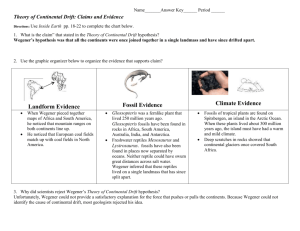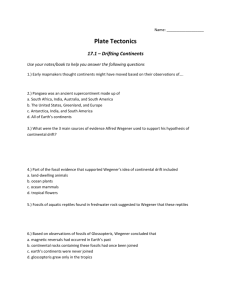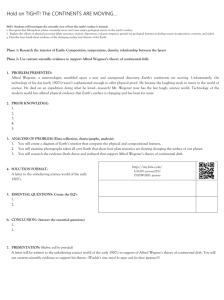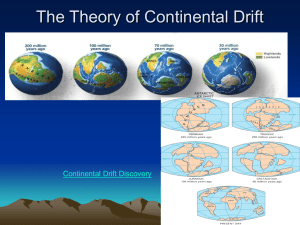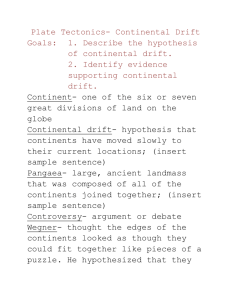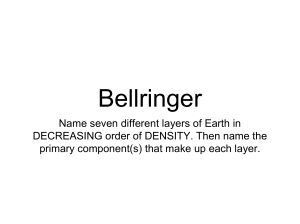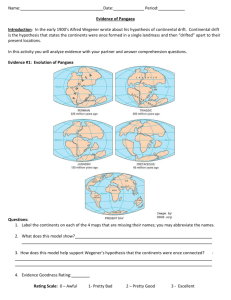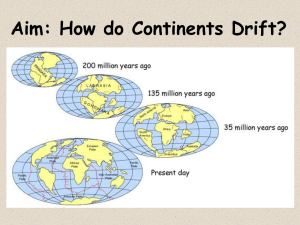Evidence for Continental Drift
advertisement
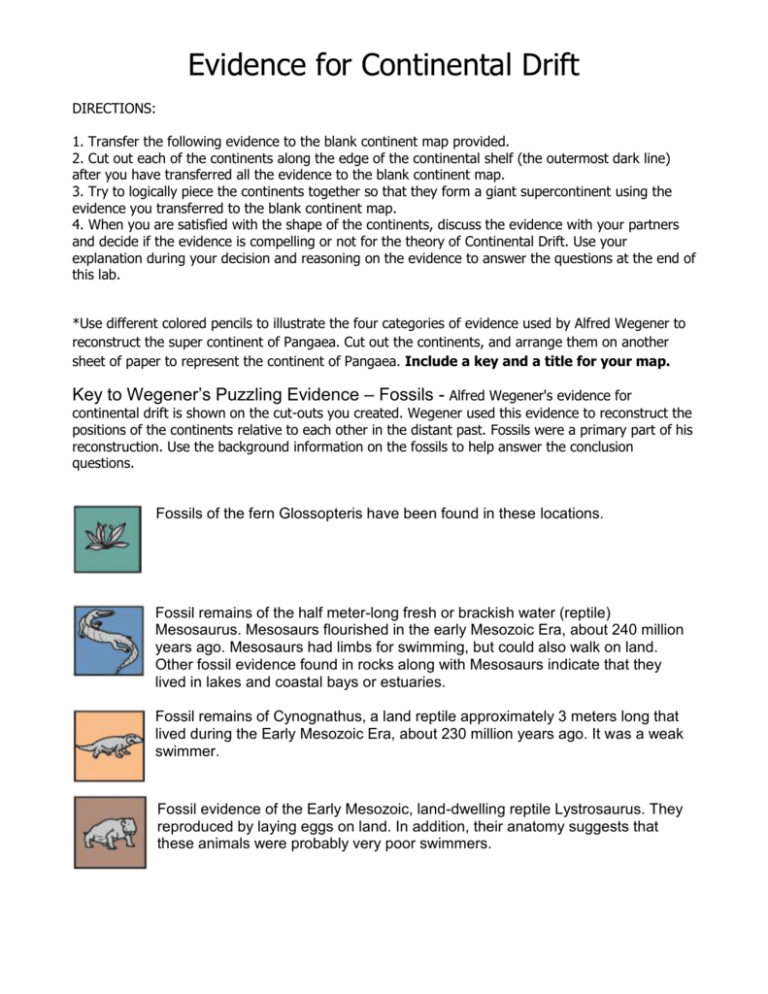
Evidence for Continental Drift DIRECTIONS: 1. Transfer the following evidence to the blank continent map provided. 2. Cut out each of the continents along the edge of the continental shelf (the outermost dark line) after you have transferred all the evidence to the blank continent map. 3. Try to logically piece the continents together so that they form a giant supercontinent using the evidence you transferred to the blank continent map. 4. When you are satisfied with the shape of the continents, discuss the evidence with your partners and decide if the evidence is compelling or not for the theory of Continental Drift. Use your explanation during your decision and reasoning on the evidence to answer the questions at the end of this lab. *Use different colored pencils to illustrate the four categories of evidence used by Alfred Wegener to reconstruct the super continent of Pangaea. Cut out the continents, and arrange them on another sheet of paper to represent the continent of Pangaea. Include a key and a title for your map. Key to Wegener’s Puzzling Evidence – Fossils - Alfred Wegener's evidence for continental drift is shown on the cut-outs you created. Wegener used this evidence to reconstruct the positions of the continents relative to each other in the distant past. Fossils were a primary part of his reconstruction. Use the background information on the fossils to help answer the conclusion questions. Fossils of the fern Glossopteris have been found in these locations. Fossil remains of the half meter-long fresh or brackish water (reptile) Mesosaurus. Mesosaurs flourished in the early Mesozoic Era, about 240 million years ago. Mesosaurs had limbs for swimming, but could also walk on land. Other fossil evidence found in rocks along with Mesosaurs indicate that they lived in lakes and coastal bays or estuaries. Fossil remains of Cynognathus, a land reptile approximately 3 meters long that lived during the Early Mesozoic Era, about 230 million years ago. It was a weak swimmer. Fossil evidence of the Early Mesozoic, land-dwelling reptile Lystrosaurus. They reproduced by laying eggs on land. In addition, their anatomy suggests that these animals were probably very poor swimmers. Wegener’s Puzzling Evidence 1. The following piece of evidence represents matching geologic provinces in Africa and South America. 2. The lines on the following map show Paleozoic Mountain belts on either side of the Atlantic Ocean. Matching letters represent the matching mountain chains. 3. The shaded areas on this map represent areas where there is evidence of glaciations during the Paleozoic era. 4. The various letters on this map represent evidence for the location of climate zones during the Carboniferous Period. Scientist have been able to determine the location of these zones after the study of rock, fossil and other evidence. Answer each question completely in the space provided: 1. Scientists have found Mesosaurus fossils on the east coast of the southern tip of South America and the west coast of South Africa. Even though we know this animal could swim, does the presence of the Mesosaurus fossil in two different places support Wegener theory? Give evidence to support your ideas. 2. Scientists have evidence that Glossopteris was found in what is now India, Antarctica, Australia, and Madagascar. What does this tell you about Glossopteris? What does it tell you about the climate and environment of Pangaea? 3. Based on the geologic past, we can assume that Earth is always changing. What modern-day evidence supports this idea? Hint: Think about natural disasters. Where do they often occur? 4. How do you think the theory of Continental drift helped in our understanding of plate tectonics? 5. Given enough time do you think the continents will come back together again? This page was copied with permission from the University of California, Irvine California Science Implementation Network - UCI/CSIN 1989 May be reproduced for non-profit educational uses only. The evolution of a theory - plate tectonics These events are in jumbled order. Cut them into strips and re-assemble to give the correct sequence. Paste them in correct order on the back of your completed Pangaea Map. 1912 Alfred Wegener; His ideas were published in a book in English in 1924 called, ‘The Origin of Continents and Oceans’. His idea was called ‘continental displacement’ which later became, continental drift’. His book contained five major lines of evidence: a) The jigsaw fit - the very close match between the coastlines of Africa and South America; b) Matching of the geological patterns from either side of the south Atlantic (the pattern on the jigsaw) c) Fossil evidence (Mesosaurus - a reptile, Lystrosaurus - another reptile, Antarctic beech) d) Paleoclimatic reasoning e) He attempted to show the movement of continents by the change in their distance apart, shown by timing radio transmissions over a number of years. Wegener died in 1930. 1967 Jason Morgan, Dan McKenzie and Xavier le Pichon; Developed all the earlier ideas into plate tectonic theory 1858 Antonio Snider; Published first map showing Africa and South America joined together - they broke apart during Noah’s flood. 1965 J. Tuzo Wilson; Proposed that the Earth is divided into several large rigid plates - these are moved apart as sea floors spread. 1937 Alexander Du Toit; Published, ‘Our wandering continents’. Compiled a lot of geological evidence supporting the ‘continental drift’ idea (i.e. matching rocks on either side of the Atlantic basin). 1910 F.B. Taylor; He envisaged a ‘mighty creeping movement’ of the Earth’s crust and collision with other continents to explain the Tertiary mountain belts, e.g. the Himalayas and the Alps. 1660 Francis Bacon; Noticed that the coastlines of Africa and South America had similar shapes. 1963 Fred Vine and Drummond Matthews; Explained the symmetrical magnetic stripes on the ocean floor in terms of sea floor spreading. 1956 S.K. Runcorn; Paleomagnetic evidence from continental rocks appeared to show that the magnetic poles of the Earth had moved - ‘polar wandering’ (it was later shown that not the poles but the continents had moved). 1904 Eduard Suess; The rock structures on either side of the Atlantic were very similar - but this was explained by the collapse below sea level of a supposed continent in between – “Atlantis”. 1962 Harry Hess; Proposed that new ocean floor was made in the centres of oceans and then carried sideways on convection current conveyor belts - this became called the ‘sea floor spreading hypothesis’. 1929 Arthur Holmes; Proposed that there were convection currents in the mantle below the crust.

